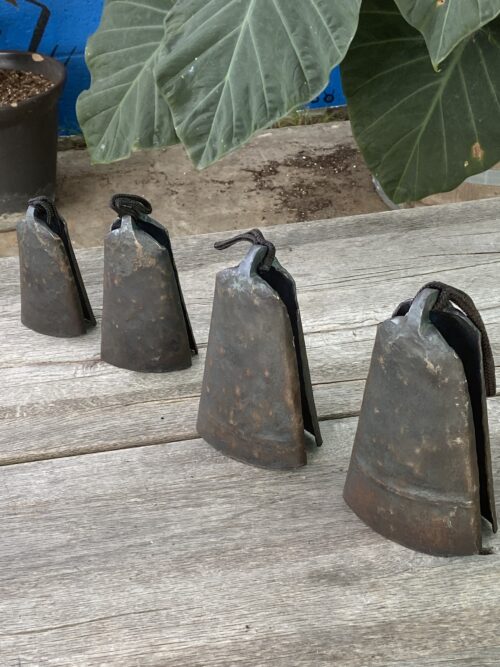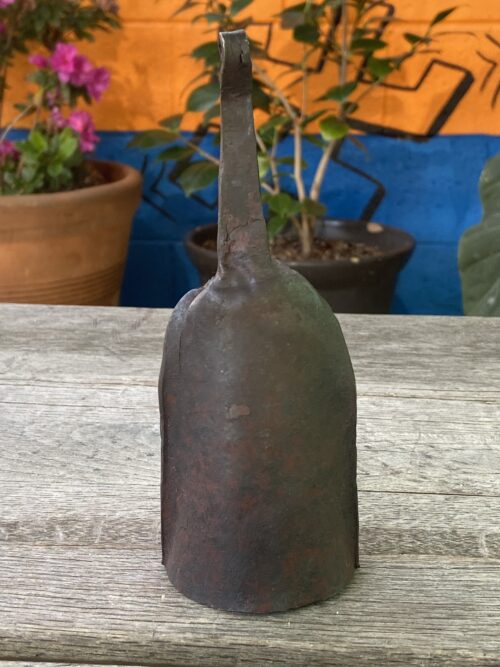- handcrafted double bell from Ghana
- high and low tones
- playing stick included
Gankoqui
$10.00 – $60.00
Description
The Gankoqui is a vibrating iron bell/gong, hand-forged bya blacksmith into a distinctive traditional shape. Popularly referred to as gakpevi (ga = forged iron + kpe = carrying + vi – child), i.e., “forged iron carrying a child.” The basic form of a gankoqui consists of a larger low-pitched forged bell and a smaller higher-pitched bell permanently mounted together. The larger forged-iron bell/gong is referred to as the “parent” and the smaller, higher-pitched bell is referred to as the “child” (in the fanciful “protective custody” of its “parent” bell).
The Gankoqui bell/gong creates a rhythmic pulse foran entire ensemble. Its voice provides the basic meter/background over which most Anlo-Ewe music is structured. In these cultures a performer may be said to be ‘playing blind’ if he or she lacks a keen sense of and syncronization with the gankoqui’s basic guiding patterns. The gankoqui was also adopted and modified in Brazil into what is called an Ágogo (also later called a “go-go bell” and sold in inferior commercial production versions). The genuine hand-made gankoquis sold by Motherland Music provide a rich traditional palette of musical timbres with the right techniques, not just two basically-dull notes. Like our hand-carved drums, these are the real things, hand-made in Africa.
A Gankoqui, like a drum, is meant to serve as a surrogate for human communication—imitating the manner in which the mouth produces speech. It is played with a stick technique while held in one hand and resting on the thigh of the usually-seated performer (who sits with a firm but relaxed body; being seated enables this technique). As the hands go into motion, the stroke is supported from the elbows, and the actual stick movement is done from the wrist. The (‘sweet spot’ of the) stick strikes the full rounded portion of the bell (approx. its center mass, but more toward the open end) to achieve the most sonorous bell/gong tone. When the smaller (higher-pitched) top bell is in use, the forged-iron larger bell structure rests (and is muted/dampened) on the thigh. When the larger (lower-pitched) bottom bell is struck, it is usually while it is first raised slightly above the thigh so it will not be muted. Stopping the resonance of the lower pitch (by dampening it on the thigh after it is played) is analagous to closing one’s mouth—this helps the player to indicate basic notes, pauses and phrases with which gankoqui rhythms are composed. In Anlo-Ewe music, the gankoqui is played with a high degree of proficiency using lively, colorful techniques and rhythmic motives. Since it thoroughly penetrates even an active, loud drum ensemble (like the Ágogo does in Brazilian carnival music called samba), the gankoqui may be said to provide an easily-recognizable “flavor” that powers certain traditional African drum ensemble music. In the sense that it is a double bell/gong, the term gankoqui is singular in use (no final ‘s’) and plural in construction.
Performance Techniques And Timbres
Two basic types of stick techniques are used in the art of playing gankoqui: bounced and pressed. The bounced (“Tin”) technique lets the stick rebound after it strikes the gankoqui (allowing the instrument to speak openly), and the pressed (“Go”) technique releases a partially-muted tone by pressing the stick firmly on the gankoqui, preventing the stick from bouncing (and pinching/preventing the bell/gong from fully resonating) after the stroke is played, producing a high, dry timbre.
Gankoqui “Tin” Tone: A bounced stroke across the top of the “parent” forged-iron bell/gong produces a low-pitched, ringy, open tone (called “Tin” in vocalise).
Gankoqui “Go” Tone: A bounced stroke across the top of the “child” forged-iron bell/gong produces a high-pitched tone (called “Go” in vocalise).
Gankoqui “Ka” Tone: A pressed stroke across the top of the “child” forged-iron bell/gong produces a dry and even higher-pitched tone (called “Ka” in vocalise).
A Note on Stick Striking Positions
A stick striking position contacting the bell/gong near the stick’s “sweet spot” (approx. 1/3 from the end opposite the one held) will produce a fuller, more resonant timbre (as long as it is near the center mass of the bell/gong). This may contrast well with use of a striking position near the tip of the stick for other notes, since this produces a far “drier” timbre. ‘Proper’ stick position (toward or distant from the stick end not held) can help to more distinctly produce both the bell’s open and muted (also called “dead”) strokes. More-experienced players may position the playing stick more toward its tip (in varying degrees) and/or vary stick position gradually while playing in order to produce more shades of the “Ka” tone (or rising/falling notes). As in all things musical, well-prepared masters have larger musical vocabularies and can be more expressive.
Additional information
| Weight | N/A |
|---|---|
| Dimensions | N/A |
| COUNTRY OF ORIGIN | Ghana |
| PLAYING TECHNIQUE | Held and struck |
| BELL TYPE | Double |
| SOUND QUALITIES | Clangy, Ringy |




